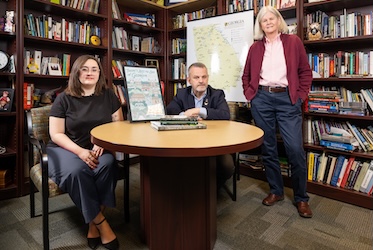
Professor’s research examines how COVID-19 graphs may miss the mark
KENNESAW, Ga. | Jan 21, 2021

Charts and graphs are common tools for people to share and discuss data surrounding the COVID-19 pandemic, but those visuals may have the potential be misinterpreted by audiences, according to Kennesaw State University’s Sara Doan.
Doan, assistant professor of technical communication, has studied graphs and charts published by media companies and magazines during the pandemic, revealing instances of misinformation – either intentional or unintentional – that give audiences skewed perceptions of the virus’ spread and effect on society.
“Misinformation is one of the big problems of our time,” Doan said. “Within COVID-19, there have been so many times where data has been misrepresented, downplayed or minimized, so I’ve been looking specifically at charts and graphs from the early part of the epidemic when people in the United States were just starting to realize that COVID was going to be a big thing.”
While technology has allowed for more people to create and share visual representations, Doan posits that technology has allowed people to become their own publicists, potentially leading to more cases of graphical misinterpretation. According to Doan, people in the United States and western Europe tend to associate diagrams with scientific and logical thinking – meaning that, if people can see data visually, they tend to trust it. This creates a problem because charts can be cherry-picked, or the captions and labels of the chart might not tell the whole story.
According to Doan, a national magazine shared a series of four pie charts in March 2020 that compared the number of fatal cases of COVID-19 with the seasonal flu, Severe Acute Respiratory Syndrome (SARS) and Middle East Respiratory Syndrome (MERS). The data was technically accurate, but the groupings were possibly misleading.
“The pie charts did not consider the rate of spread of the diseases and that COVID is very, very contagious,” Doan said. “The charts also did not humanize the data because COVID-19 is having such a disproportionate impact on African American and Native American communities as well as the working class. The charts made it look like COVID was going to be less severe, when it really isn’t.”
Doan found another example of a misleading graph published by a TV news organization in Denver that deliberately adjusted the logarithmic scale on the vertical Y-axis of the chart to make it seem like the surge of COVID-19 cases in Colorado from March 21 to March 22, 2020 was smaller than it really was, creating the potential for people to downplay the rate of the virus’ spread at the beginning of the pandemic.
To hear more about Doan’s research and findings, listen to the “Thought Provoking” podcast hosted by KSU’s Norman J. Radow College of Humanities and Social Sciences.
Related Stories

First-year Kennesaw State student, author recognized as versed local historian

Kennesaw State student leverages Double Owl Pathways program to accelerate career path

Kennesaw State student uplifts community through film work, fellowship

Kennesaw State alumni, professor offer guide to Georgia's historic sites in new book
A leader in innovative teaching and learning, Kennesaw State University offers undergraduate, graduate, and doctoral degrees to its more than 47,000 students. Kennesaw State is a member of the University System of Georgia with 11 academic colleges. The university’s vibrant campus culture, diverse population, strong global ties, and entrepreneurial spirit draw students from throughout the country and the world. Kennesaw State is a Carnegie-designated doctoral research institution (R2), placing it among an elite group of only 8 percent of U.S. colleges and universities with an R1 or R2 status. For more information, visit kennesaw.edu.














